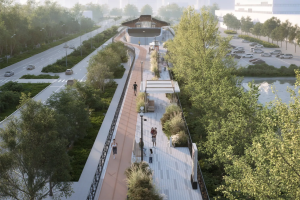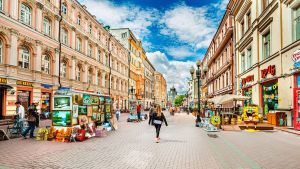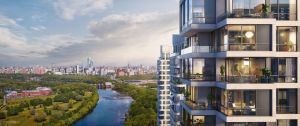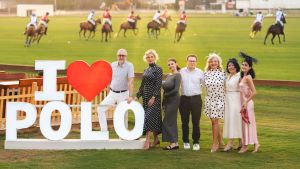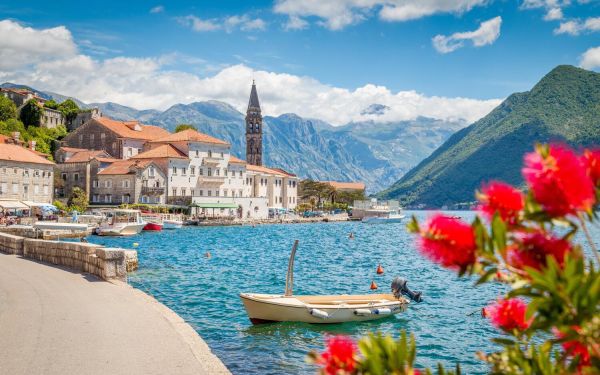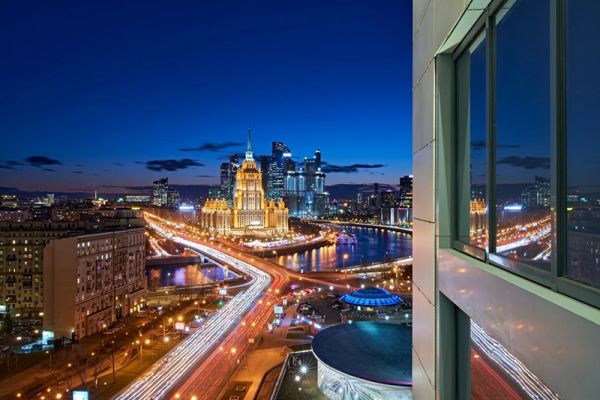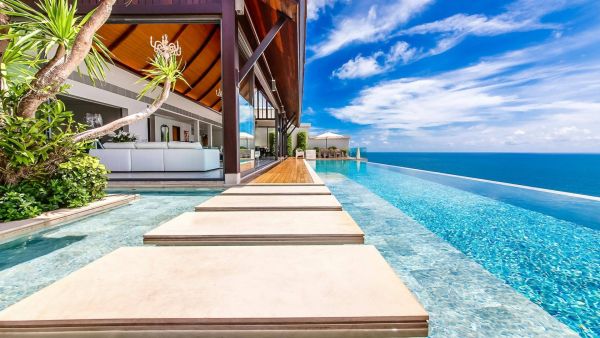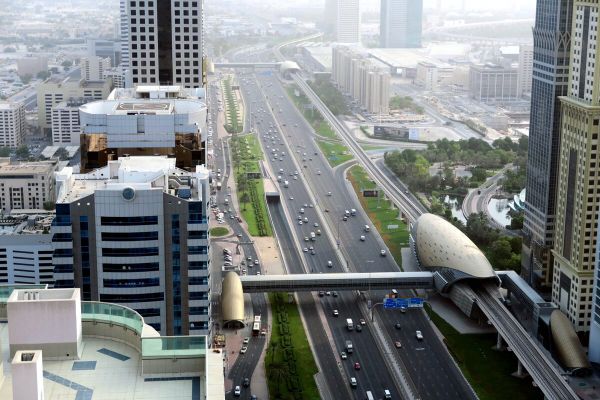The sporty lifestyle, its Moscow adherents and their ambitious developers
Read 16.5 min
118
According to research, a third of buyers of new buildings consider the presence of a sports center or a park with a workout area within walking distance to be one of the key factors in choosing a property. Sports infrastructure has already become part of a gentleman's set of modern residential complexes.
During last year's joint research, analysts of the Avito Work platform and the FITMOST single subscription found out that for Russians, sports are among the three most popular ways of self-support and stress relief. And in general, within the framework of the national goal "Preservation of the population, health and well-being of people" by 2030, the share of citizens systematically engaged in physical education and sports should grow to 70%: this indicator is fixed by the decree "On national development goals of the Russian Federation for the period up to 2030", which the President of the country signed in 2020.
Of course, in order to achieve such an ambitious mark, sports and recreation infrastructure, firstly, must be, and secondly, must be affordable in terms of not only price, but also location. Because even the hottest physical education enthusiasm can come to naught if you have to get to the pool, gym or fitness center for hours on a crossbar. So the attention of buyers to the presence of some sports facilities or sports zones in the residential complex is usually as close as possible: according to the Rodina group*, three out of four Russians admit that they would be motivated to play sports and lead a healthy lifestyle by having a park within walking distance, and the specialists of Touch in general it is claimed* that a third of potential buyers of new buildings consider the presence of a sports center or a park with a workout area within walking distance to be one of the key factors influencing the choice of real estate.
How do developers react to such a sporty mood of buyers? According to a joint survey recently conducted by Atlas Consulting bureau and the Russian Guild of Managers and Developers (RGUD)*, "developers record an increased interest in the topic of landscaping on the part of buyers. According to 87% of respondents, it was the pandemic and the transition to remoteness that created a special demand for residential complexes with high-quality landscaping, including zoning, landscaping and a variety of children's and sports grounds. 75% of developers are convinced that landscaping is the determining factor when choosing a residential complex among options comparable in price and location."
However, as the authors of the study note, only 56% of developers partially or fully implement the standards of improvement (including sports) of public spaces. The remaining 44% of respondents admitted that every time they develop an improvement project from scratch, without taking into account the experience of operating courtyards in implemented residential complexes.
According to the observations of Irina Morozova, Marketing and PR Director of Time Development, it is important for sports-oriented residents to have outdoor simulators, multifunctional playgrounds for football, volleyball and so on in the complex. "The tone is set by the leading developers of the market, who involve architectural bureaus to design playhouses. There are, of course, standards, tags and improvement SNiPs, we comply with them, but we also try to offer some kind of exclusive, based on modern requirements and expectations of residents: in particular, we have provided for the creation of a universal sports ground in our project - this is basketball, volleyball and football in summer and ice hockey in winter," says expert.
But here are some "sports observations" shared by the managing president of INST GROUP Dmitry Yudashkin: "The development of residential complex territories through sports and event infrastructure makes it possible to highlight an object in a competitive environment, increase the demand from the target audience for residential and commercial infrastructure, and ensure the economic sustainability of the project for the developer. Unfortunately, at present we still encounter poor quality sports infrastructure. What is it expressed in? In short, they are building the wrong thing and the wrong place. In practice, these are often either small playgrounds with very poor sports functionality that is not interesting or insufficient for a modern consumer, or a very large area of sports territory where substandard, outdated and unsafe equipment is presented. As a result, very low attendance at venues, and sometimes injuries or even accidents."
At the same time, the experts of the Kalinka ecosystem* studied the data of the "Single Resource of Developers", which makes it possible to understand how things are with the sports infrastructure in 47 metropolitan complexes (with the exception of TiNAO) that play in the business+ and premium league and have commissioning dates in 2023-2025. As a result, a sports rating of projects was even compiled, which was based on such factors as the variety of summer and winter sports programs, the level of availability of fitness centers within walking distance (less than 2 km) and a variety of fitness programs in them, as well as the availability of a swimming pool within the same walking distance.
In general, according to the results of the study, about 20% of the projects in this segment have sports infrastructure (fitness center or fitness zone, sports fields, and so on). However, only 8% of the analyzed business+ and premium class projects within old Moscow will simultaneously offer residents a variety of summer and winter sports, at least four fitness programs and a swimming pool within walking distance.
And in general, with an average assessment of sports infrastructure of 1.26 points (which residential complexes scored all together), only four projects (the Achievement House, the Soyuz residential complex, the Badaevsky residential Complex and the Club City on the Primavera River) were able to overcome the bar of two points and topped the top 10 complexes, the most provided with sports infrastructure. Meanwhile, as Kalinka Ecosystem experts emphasize, in the Moscow housing market, the development of sports infrastructure can contribute to an increase in the cost of apartments and apartments up to 10-15%.
The combination of a forest or park, a reservoir and high-quality sports facilities can be considered ideal for sports-oriented people and adherents of a healthy lifestyle. However, on the map of Moscow, the analysts of the Rodina group identify only 12 such territories: three in the south (the Tufel Grove on the ZIL peninsula, the cascade of Kirovograd ponds near the Bitsevsky Forest and the defile between the Moscow River and Borisovsky Ponds with the park of the same name, to which the Tsaritsyno Museum-Reserve adjoins) and the northwest (Mnevnikovskaya floodplain, the coastal zone of the Moskva River above the confluence of the Khimki River and the northern part of the Shchukino district, which is located near the Pokrovskoye-Streshnevo Park and the Ivankovsky Ponds chain), there are two in the north (around the Festival and Golovinsky Ponds) and in the west (near the Mosfilm film studio and in the Ramenka River valley) and only one in the southwest (around Vorontsov Park) and northeast (a park array forming on both banks of the Yauza and quickly filling with elements of sports infrastructure).
"A pronounced emphasis on sports infrastructure is the most natural and productive way to develop locations with an extraordinary landscape, for example, a park, an interesting terrain, a river or a pond. But it is important that the efforts of the city authorities and the construction industry are directed in one direction, mutually supporting each other. Then the buyer will get the environment that will provide him with the proper quality of life, will allow him to take full care of his health," Vladimir Shchekin, founder of the Rodina group, is sure.
For reference: the minimum budget required to settle in a location with a developed sports infrastructure and a favorable natural environment is currently 6.31 million rubles — that's how much a studio in a new building on the border of the Bitsevsky forest costs, the company's analysts share data.
Of course, the local sports infrastructure has already become part of the gentleman's set of any new residential complex (even regardless of its class). But sometimes developers create large, sometimes iconic sports facilities for Moscow, whose zone of influence becomes the entire district, or even the entire city. What parameters allow us to say that the sports facility outgrows the definition of "part of the internal infrastructure of the residential complex" and becomes essentially city-forming?
According to Vasily Kvlividze, Commercial director of COLDY, this is the scale of the project, its composition and content. In particular, 14 thousand square meters, not only FOK, but also professional ice arenas of the NHL standard, Igor Larionov hockey school, Tatiana Volosozhar figure skating center, Dmitry Nosov judo school — this set gives reason to consider the SPORT Gate cluster as part of the N'ICE LOFT project as a new point of sports attraction for at least the entire South-east of Moscow.
In the project "Suburb of Lesnoye", a sports arena has been operating for two years, on the basis of which the football academy "Bars" has been opened, residents of the Prominent and southern districts of Moscow come to this sports complex with an area of 6.9 thousand square meters, and rather it can be called a sports facility of regional scale. But in the residential complex "New Vnukovo", the country's first training center for the national teams of the Russian Basketball Federation with an area of almost 9 thousand square meters is being created: it will be possible to hold championships, championships, cups of Russia and other official competitions, including international sporting events. This sports facility should definitely become a center of attraction for all basketball fans.
A very recent example is the Irina Viner Palace of Sports and Education, recently opened in New Moscow, as part of the Russian Design District project, with a gymnasium for two carpets, designed according to the standards of the International Gymnastics Federation, and a martial arts school. In Rostokino, as part of the reconstruction of the Iskra stadium and the implementation of the youth and health sports cluster, a large sports and recreation complex with an area of almost 13 thousand square meters is being built, which is designed to change the status of the district and increase its competitiveness by modernizing outdated infrastructure. After the reconstruction, 20 Olympic sports will be presented here, including figure skating and hockey, tennis and swimming, fencing and sambo, which received full recognition from the International Olympic Committee at the 138th session of the IOC. The list goes on and on.
How much do serious sports facilities increase the capitalization of the surrounding area? What does it cost to build a large sports complex and at whose expense is it usually created? To the questions BFM.ru representatives of companies whose name is associated with urban-scale sports construction responded.
Vasily Kvlividze, Commercial Director of COLDY
"The appearance of large sports clusters, of course, significantly increases the attractiveness of the location, especially when they appear on the site of former industrial territories that are being actively developed today. A striking example is the Otkritie Bank Arena stadium, which, like the new Spartak metro station, has become a powerful driver for attracting developers to the development of the territories of the Tushinsky airfield and one of the important USPS of residential complexes under construction there. And of course, the integration of a large—scale sports cluster into the residential complex increases its attractiveness to buyers, since it expands the pool of available internal infrastructure of the project, and also becomes a point of attraction for businesses, primarily retail and services, since such facilities generate high third-party traffic - we see this from our own experience in the N'ICE LOFT project. With the approach of the commissioning date, the interest of buyers in the premises of street retail is growing rapidly: after all, the sports cluster as part of the project will be introduced simultaneously with all the houses. If we talk about sports facilities within the framework of new residential quarters, then, of course, they are being built at the expense of the developer. In the future, everything depends on the strategy of the developer: someone sells the building to specialized operators (for example, fitness centers), who will use it in the future. Someone rents out, thereby diversifying their business. However, in general, this is a non-core asset for a developer. In the case of SPORT Gate, we plan to go the other way. Now we are considering the possibility and are negotiating with one of the largest management companies in the asset management segment to create a ZPIF: infrastructure of this level is a very popular asset for the rental business. Given the scale and uniqueness of the sports cluster, the project will be in demand among Moscow residents, which will provide it with high traffic and stable rental income."
Ayman El-Hashem, Managing Director of the development unit of the Aeroplane Group for the Moscow region
"A large sports facility — in this case we are talking about unique specialized centers where large—scale competitions are held or its own sports school operates - can become a symbol of the location. Such centers attract people and investments to the area, "overgrow" additional infrastructure, create jobs and affect, rather than the capitalization of the territory, but to increase the attractiveness of the area. A large-scale sports component may entail the development of the surrounding infrastructure, in particular, street retail facilities around a new point of attraction. If a sports complex involves holding All-Russian or international competitions, the location may become attractive for the hotel business or daily rent. Residential real estate can also benefit from increasing the overall prestige of the location."
Vladimir Shchekin, founder of the Rodina Group
"Depending on the scale, concept, equipment, large sports facilities implemented as part of the residential complex can become regional centers of activity, and places of federal or international significance. In residential complex projects, sports facilities become important magnets that work to increase the attractiveness of the place. In addition to apartment buyers, they attract investors, commercial tenants, create new jobs, increase the capitalization of the territory by increasing the value of real estate in the immediate environment. If we talk about large sports facilities that are becoming infrastructure dominants, then their cost is high. For example, in RDD, where the Irina Viner Palace of Sports and Education is implemented, about 2.4 billion has been invested in cultural, sports and educational infrastructure facilities."
According to expert estimates, on average, the annual maintenance costs of facilities range from 7% to 15% of the construction cost. "Therefore, it is important to immediately determine the financial model of the sports complex, at the design stage to form a high-quality and relevant purpose for the market, the format of presence in the residential complex, identify partners to create and manage this type of infrastructure and, of course, select an experienced teaching and coaching staff that will ensure success and demand," recommends Vladimir Shchekin.
Read also
Stay up to date with the latest news
We promise to send only interesting and important articles.
